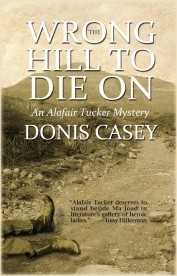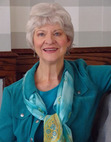Heidi M. Thomas's Blog, page 12
June 27, 2013
On Retreat in the Huachuca Mountains
 Arletta Dawdy writes from Northern California but her heart is in the 19th century American West. When immersed in the stories of strong, independent women, she has been known to get lost in their adventures. Arletta’s social work background lends itself to character development. Her extensive travels in the Southwest add believability to her settings. HUACHUCA WOMAN and BY GRACE are the first two books in The Huachuca Trilogy.
Arletta Dawdy writes from Northern California but her heart is in the 19th century American West. When immersed in the stories of strong, independent women, she has been known to get lost in their adventures. Arletta’s social work background lends itself to character development. Her extensive travels in the Southwest add believability to her settings. HUACHUCA WOMAN and BY GRACE are the first two books in The Huachuca Trilogy.
On Retreat
by Arletta Dawdy
A time for contemplation. Time to recharge my batteries. Time to take inspiration from the setting. A time to let go of daily issues, routines and people. Such were my goals in heading to southeast Arizona on a six week retreat of my own design.
I write about the Huachuca Mountains. My stories were born here on vacation and research trips by living in the area, breathing in its history and beauty, listening for the tales of bygone people. Over the years I photographed, kept journals and wrote the first two novels of the Huachuca Trilogy while in the locale and away from it. Every so often, I had to return to engage my muse, sharpen her perceptions and find the voices of my characters once again.
The story ideas found roots and growth on the high peaks washed by wind, rain and snow. Songbirds, butterflies and sixteen varieties of hummingbirds gave color and sound among the ancient oaks and silvered sycamores. Following Ramsey Creek opened the doors to my imagination with Chiricahua Apaches, Buffalo Soldiers, miners, loggers and homesteaders peopling the canyons, cliffs and desert floor.
In returning to the Huachucas this past spring, I immersed myself in the timeless domain where wandering deer and courting turkeys came to my doorstep several times a day. Turkey gobbling heralded each new morning. Late afternoon found a young deer tackling the hanging bird feeder, standing on his hind legs and snatching seeds from the rim. He honed his talent as the days went by. Three peacocks owed their existence to a sixty year history of ancestors introduced by a local rancher. No doubt his bride instigated the idea. These will be the last for all three are male, one of whom favored sitting on the carpenters horse at the edge of the driveway.
Arriving home one evening, a javelina escorted me to the cabin. Also called peccaries or skunk pigs, javelinas are native to the Americas, have a harsh odor and sharp tusks. My apprehension built as he neared the cabin and I worried that he’d go for the scattered feed or otherwise take up residence at mine! Instead he continued on his way, heading for the creek without a look back. The next day, the javelina demanded a presence in my work; a fearless young boy appeared in Rose of Sharon, my WIP, seeking a “doggie” from a gathering of javelinas. The child has no apprehension about the animals but the adults who gather fear for his safety and it is Rose who first knows of his danger and saves him.
Americas, have a harsh odor and sharp tusks. My apprehension built as he neared the cabin and I worried that he’d go for the scattered feed or otherwise take up residence at mine! Instead he continued on his way, heading for the creek without a look back. The next day, the javelina demanded a presence in my work; a fearless young boy appeared in Rose of Sharon, my WIP, seeking a “doggie” from a gathering of javelinas. The child has no apprehension about the animals but the adults who gather fear for his safety and it is Rose who first knows of his danger and saves him.
Watching spring fill trees and bushes with new leaves and blossoms renewed my sense of place with deeper connectivity and intensity. Walking about the mountains, kicking at mineral-laden rocks led to a scene in which White Buffalo makes a bracelet charm for Rose. These story threads hadn’t occurred to me sitting at my computer at home in Northern California. They took off from my retreat experience, thoughts and dreamtime in the quietude of the setting.
My manuscript had been dragging with a lack of focus and motivation in the heroine. I knew, in my head, the conflicts she faced, but they lacked the energy and vitality of well-written prose. It was as if, at home, I couldn’t feel these things and, therefore, my character couldn’t. My words were flat, lacking affect, and so I had come up empty for long blocks of time. The connectivity I sought evolved from “getting into the skin” of my characters and opening myself to convey who they truly are. That happened on retreat.
Written during a three-day retreat at the Russian River, close to home.
How do you recharge your writing batteries?
Meeting and sharing with other writers?
Going to nature and solitude?
HUACHUCA WOMAN is a work of historical fiction set in Southeast Arizona from 1886 to 1961. A veranda rail breaks. Barn filth is turning to dust. A rattler’s nest needs clearing. Peeling paint on the old house demands attention. At 75, Josephine Nichols hasn’t been up to caring for the Lazy L Ranch. She’s thinking of selling out when spring break 1952 brings the Nichols cousins to the ranch and its matriarch. Recording the treasured stories of border life as only Jo can tell them, they get more than they dreamt of, bargained for or knew. Jo’s love of the land and family are keys to her life-story. She tells of lost loves; of fears and fights against abandonment; dangerous bouts of depression threaten her stability; and guilt walks with her through too many years. The stories are framed against borderlands events and characters: Pancho Villa, Geromino, Mexican Revolution and WW1. A pact develops between the threesome to insure that the ranch endures. Nine years later, as Jo is put to rest at Sentinel Rock, The Lazy L Historical Ranch is a vibrant learning center for the preservation of the history, cultures and legends of Cochise County, not the least of which is of the HUACHUCA WOMAN.
 BY GRACE traces the heroic journey of young Grace Pelham as she travels geographically and psychologically into the Far West of the late 1890’s. Following her father’s death, she leaves Albany on a quest to find her vocation and stumbles into unexpected troubles and rewards. Thrust out on her own, she must escape the threat and murderous accusations posed by her benefactress’ nephew. With changing identities, fearsome obstacles and personal challenges along the way, Grace profoundly affects and is affected by Louis Comfort Tiffany, a married man and his family, a lost child, Jane Addams, a male-dressing horse woman/prospector, a rigid minister and his tightly corseted wife, the Irish mob, and Chinese friends. When her nemesis confronts her in a syphilitic haze, threatening to kill her and a loved one, Grace prevails. Her signatory “By Grace” is applied to her jewelry designs. The Blue Opals of southeastern Arizona’s Huachuca Mountains promise opportunity and a new life.
BY GRACE traces the heroic journey of young Grace Pelham as she travels geographically and psychologically into the Far West of the late 1890’s. Following her father’s death, she leaves Albany on a quest to find her vocation and stumbles into unexpected troubles and rewards. Thrust out on her own, she must escape the threat and murderous accusations posed by her benefactress’ nephew. With changing identities, fearsome obstacles and personal challenges along the way, Grace profoundly affects and is affected by Louis Comfort Tiffany, a married man and his family, a lost child, Jane Addams, a male-dressing horse woman/prospector, a rigid minister and his tightly corseted wife, the Irish mob, and Chinese friends. When her nemesis confronts her in a syphilitic haze, threatening to kill her and a loved one, Grace prevails. Her signatory “By Grace” is applied to her jewelry designs. The Blue Opals of southeastern Arizona’s Huachuca Mountains promise opportunity and a new life.
June 21, 2013
What’s Up, Doc?
This came across my e-mail recently and I just had to share it with you. English is truly an interesting language!
 This two-letter word in English has more meanings than any other two-letter word, and that word is ‘UP.’ It is listed in the dictionary as an [adv], [prep], [adj], [n] or [v].
This two-letter word in English has more meanings than any other two-letter word, and that word is ‘UP.’ It is listed in the dictionary as an [adv], [prep], [adj], [n] or [v].
It’s easy to understand UP, meaning toward the sky or at the top of the list, but when we awaken in the morning, why do we wake UP?
At a meeting, why does a topic come UP? Why do we speak UP, and why are the officers UP for election and why is it UP to the secretary to write UP a report? We call UP our friends, brighten UP a room, polish UP the silver, warm UP the leftovers and clean UP the kitchen. We lock UP the house and fix UP the old car.
At other times, this little word has real special meaning. People stir UP trouble, line UP for tickets, work UP an appetite, and think UP excuses.
To be dressed is one thing but to be dressed UP is special.
And this UP is confusing: A drain must be opened UP because it is stopped UP.
We open UP a store in the morning but we close it UP at night. We seem to be pretty mixed UP about UP!
To be knowledgeable about the proper uses of UP, look UP the word UP in the dictionary. In a desk-sized dictionary, it takes UP almost 1/4 of the page and can add UP to about thirty definitions.
If you are UP to it, you might try building UP a list of the many ways UP is used. It will take UP a lot of your time, but if you don’t give UP, you may wind UP with a hundred or more.
When it threatens to rain, we say it is clouding UP. When the sun comes out, we say it is clearing UP. When it rains, it soaks UP the earth. When it does not rain for awhile, things dry UP. One could go on and on, but I’ll wrap it UP, for now . . . my time is UP!
Oh . . . one more thing: What is the first thing you do in the morning and the last thing you do at night?
U
P!
Did that one crack you UP?
Don’t mess UP. Send this on to everyone you look UP in your address book . . .. or not . . . it’s UP to you.
Now I’ll shut UP!


June 14, 2013
Celebrate Flag Day
 Today, June 14, is Flag Day. It commemorates the adoption of the flag of the United States, in 1777 by resolution of the Second Continental Congress. The United States Army also celebrates its birthday on this date.
Today, June 14, is Flag Day. It commemorates the adoption of the flag of the United States, in 1777 by resolution of the Second Continental Congress. The United States Army also celebrates its birthday on this date.
The tradition of the first flag day observance began on June 14th, 1885. Bernard J. Cigrand, a 19- year-old teacher at Stony Hill School in Waubeka Wisconsin, placed a 10 inch, 38- star flag in a bottle on his desk then assigned essays on the flag and its significance. This observance was also the beginning of Cigrand’s long years of fervent and devoted effort to bring about national recognition and observance of Flag Day. The crowning achievement of his life came at age fifty when President Wilson, on May 30, 1916, issued a proclamation calling for a nationwide observance of Flag Day. Then in 1949, President Truman signed an Act of Congress designating the 14th day of June every year as National Flag Day.
Flag Day is not an official federal holiday; it is at the President’s discretion to officially proclaim the observance. On June 14, 1937, Pennsylvania became the first (and only) state to celebrate Flag Day as a state holiday. New York statutes also designate the second Sunday in June a state holiday as Flag Day.
Perhaps the oldest continuing Flag Day parade is at Fairfield, Washington. Beginning in 1909 or 1910, Fairfield has held a parade every year since, and celebrated the “Centennial” parade in 2010, along with s other commemorative events.
One of the longest-running Flag Day parades is held annually in Quincy, Massachusetts, which began in 1952. The 59th Annual Appleton, Wisconsin 2009 Flag Day Parade featured the U.S. Navy. The largest Flag Day parade is held annually in Troy, New York, which bases its parade on the Quincy parade and typically draws 50,000 spectators.
Federal law stipulates many aspects of flag etiquette. The section of law dealing with American Flag etiquette is generally referred to as the Flag Code. Some general guidelines from the Flag Code answer many of the most common questions:
The flag should be lighted at all times, either by sunlight or by an appropriate light source.
The flag should be flown in fair weather, unless the flag is designed for inclement weather use.
The flag should never be dipped to any person or thing. It is flown upside down only as a distress signal.
The flag should not be used for any decoration in general. Bunting of blue, white and red stripes is available for these purposes. The blue stripe of the bunting should be on the top.
The flag should never be used for any advertising purpose. It should not be embroidered, printed or otherwise impressed on such articles as cushions, handkerchiefs, napkins, boxes, or anything intended to be discarded after temporary use. Advertising signs should not be attached to the staff or halyard.
The flag should not be used as part of a costume or athletic uniform, except that a flag patch may be used on the uniform of military personnel, fireman, policeman and members of patriotic organizations.
The flag should never have any mark, insignia, letter, word, number, figure, or drawing of any kind placed on it, or attached to it.
The flag should never be used for receiving, holding, carrying, or delivering anything.
When the flag is lowered, no part of it should touch the ground or any other object; it should be received by waiting hands and arms. To store the flag it should be folded neatly and ceremoniously.
The flag should be cleaned and mended when necessary.
When a flag is so worn it is no longer fit to serve as a symbol of our country, it should be destroyed by burning in a dignified manner.
Read a more comprehensive set of flagetiquette rules for display of the American Flag.
Do you celebrate Flag Day? Do you fly a flag?


June 6, 2013
Meet WILLA Award Author Janet Fox
Janet Fox’s Young Adult novel, Forgiven, was a WILLA Literary Award Finalist in the 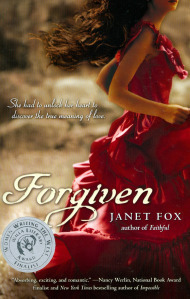 Women Writing the West’s 2012 competition, and it is a story well-deserving of this award. This is a companion novel to Faithful, which takes place in Yellowstone Park in Montana.
Women Writing the West’s 2012 competition, and it is a story well-deserving of this award. This is a companion novel to Faithful, which takes place in Yellowstone Park in Montana.
Synopsis: Flirting on the edge of danger, Montana girl Kula Baker finds herself on the streets of San Francisco, alone but for a letter of introduction. Though she has come to the city to save her father from a cruel fate, Kula soon finds herself swept up in a world of art and elegance – a world she hardly dared dream of back in Montana, where she was no more than the daughter of an outlaw. And then there is the handsome David Wong, whose smiling eyes and soft-spoken manner have an uncanny way of breaking through Kula’s carefully crafted reserve. Yet when disaster strikes and the wreckage threatens all she holds dear, Kula realizes that only by unlocking her heart can she begin to carve a new future for herself.
Welcome, Janet, and congratulations again on your award. Tell us how Forgiven evolved. Did you start with the idea of writing a story centered around the 1906 San Francisco Earthquake or with the character?
I began with the character – although I’ll confess that setting forms an integral part of my 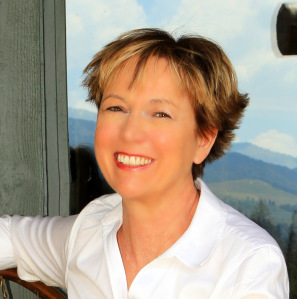 early process. Kula is a secondary character in my first novel, Faithful, and I fell in love with her. But she’s a tough character, and initially my editor was leery; she worried that readers wouldn’t be able to connect with her. When I submitted the draft, I’m happy to say Jen changed her mind – or maybe Kula changed Jen’s mind.
early process. Kula is a secondary character in my first novel, Faithful, and I fell in love with her. But she’s a tough character, and initially my editor was leery; she worried that readers wouldn’t be able to connect with her. When I submitted the draft, I’m happy to say Jen changed her mind – or maybe Kula changed Jen’s mind.
I do like to create events in my historical world/fictional world that would interest readers beyond the story arc, and in that sense, taking Kula to San Francisco at the time of the great earthquake seemed like a perfect fit. Kula’s world is shaken to its foundations metaphorically and literally.
What made you decide on the genre of young adult historical romance?
I’ve been writing most of my life but my early projects were all for adults. It wasn’t until my mother died, and I found among her papers a stack of unpublished children’s stories, that I realized that my voice is that of a young person. I guess you could say I suffer from arrested development. As for historical, I’ve always loved history, and it seemed to fit the character of Maggie in Faithful, who popped into my head one day as I was taking a walk, and then she just wouldn’t leave me alone. And the romance: aren’t all young women obsessed with romance? I know I was, so I just put myself back in those shoes and relived all the aches and pains and desires I had as a teen.
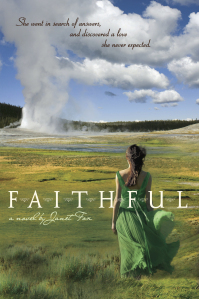 And why the setting of Montana?
And why the setting of Montana?
That walk I was taking? That was here in Montana one summer day when we were in our cabin in the mountains. Maggie wormed her way into me through the magic of those mountains. And then I had to send her to Yellowstone, which is both beautiful and treacherous, because what she was living through had to push her way outside her comfort zone. Again the setting resonated with the underlying theme.
Kula began in Yellowstone because that’s where we meet her in Faithful, and her core values and ideas are formed as a result of her upbringing there and then in time spent in Bozeman.
What is the insight you, as an author, received from writing these books and what do you hope your readers will take away?
Interesting question. I don’t consciously look for my theme up front when I begin a new project; I always start with a character and a snip of a situation. I never know what will evolve from that. It’s only in the later stages of drafting that I begin to identify my “theme” – what my readers might take away, what Thomas McCormack calls the “master-effect” – so that I can tie imagery and symbolism together to make a resonant whole. Each of my novels does something different in that regard.
I suppose, though, that what I’m doing when I write is searching for meaning. I’m looking for answers. I guess if I ever really find those answers, I’ll stop writing; and for the moment I have no plans to stop writing.
Do you have a favorite author who has inspired you?
I have many. From Dickens, I’ve tried to learn the art of the cliff-hanger. From Austen, the beauty of the perfect sentence. Suzanne Collins (The Hunger Games), crafts constant tension; M.T. Anderson (The Astonishing Life of Octavian Nothing) does historical with rich resonance and veracity; Tolkien constructs evocative settings; Hemingway writes lean and spare; Joyce writes with poetry. I admire many, many contemporary kidlit authors: Maggie Steifvater, Rita Williams-Garcia, Laurie Halse Anderson, John Green, Laini Taylor, Gary Schmidt, Polly Horvath, Richard Peck, Judy Blundell….I could go on and on.
When did you first consider yourself a writer?
When I was in third grade.
Seriously, my third grade teacher sent a poem I wrote to the town paper, and when I saw my name in print, that was it. I was hooked, and never stopped thinking about becoming a writer.
Have you mentored other writers?
Yes, I hope so! I’ve given critiques as donations for various charities, and I’ve spoken at many writers’ conferences. I taught high school for four years and I love encouraging young writers; a young woman here locally won a contest that included my mentorship, and she has great talent and promise. I like to encourage writers. But I do have to limit the amount of time I give away, because I have many projects waiting for me.
What advice do you have for kids who aspire to write?
Read. Read all the time. Search for support and don’t be discouraged – it takes time to build skills. When you’re ready, study the craft. Find a support network – I joined the Society of Children’s Book Writers and Illustrators (SCBWI) early in my career, and the advice and information I gathered there was crucial. Keep writing, and try writing different things in different genres; you might find your voice in picture books or in poetry or in westerns. Don’t give up.
Your third YA novel, Sirens, is now available. Is this part of your series or is it a 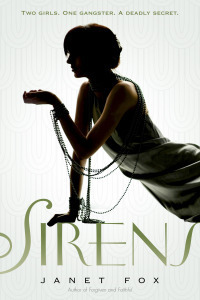 departure?
departure?
Sirens is a definite departure. For one thing, it’s set in 1925 New York. For another, it’s slightly edgier than the first two, with gangsters and Prohibition, and a missing brother who may or may not be dead and who may or may not be a ghostly presence.
What project are you working on now?
I have three projects in various stages, and they are a real departure for me. Two of them are middle grade fantasies (although one does have historical elements) and the third is a young adult science fiction novel. I move back and forth between them as I finish drafts, or as my agent is reading. I don’t like to be idle.
You are traditionally published by Speak, an imprint of Penguin. How difficult was it to land that first contract? And do you have an agent?
I do have an agent, Alyssa Eisner Henkin, and I’ve been with her since before she sold Faithful. She is instrumental in focusing my career. She came from the editorial world, so she is hands-on with my projects, giving me lots of feedback and nurturing them until they are ready to sell. I had sold my very first book, Get Organized Without Losing It (Free Spirit Publishing, 2006), on my own, but I’m thrilled to have Alyssa on my team.
Learn more about Janet on her Website.
The other two important things I did for my career was join SCBWI, and I went back to school (Vermont College of Fine Arts) for my MFA in writing for children. Both of those steps took me from a wanna-be writer to a serious and committed author. I’ve been lucky, but I’ve also been determined to grow and learn, and that’s really what it takes.


May 29, 2013
Amateur Sleuth Series Starts With Bobby’s Diner
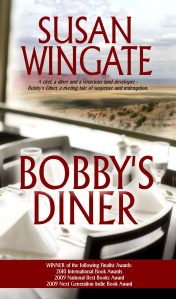 I recently had the pleasure of reading Susan Wingate’s Bobby’s Diner, the winner of several finalist awards, including the 2010 International Book Awards. The book was first picked up and published by Cambridge Books in Cambridge, Mass., and later, after regaining the rights, Susan released it herself. Book 2 in the amateur sleuth series, Hotter than Helen, was released last week and Book 3, Sacrifice at Sea, will be released later this summer.
I recently had the pleasure of reading Susan Wingate’s Bobby’s Diner, the winner of several finalist awards, including the 2010 International Book Awards. The book was first picked up and published by Cambridge Books in Cambridge, Mass., and later, after regaining the rights, Susan released it herself. Book 2 in the amateur sleuth series, Hotter than Helen, was released last week and Book 3, Sacrifice at Sea, will be released later this summer.
Susan, tell us what inspired you to write Bobby’s Diner. Was this your first book?
This was my second novel. It came to me in a dream which started this series. The dream sequence is the one you’ve read where Georgette Carlisle, the main character, hitches a ride with a scoundrel of a trucker to the place where she finds the restaurant Bobby’s Diner and where she ultimately plants her life.
Are the characters or any of the incidents based on real life?
Only the Bobby character but, as you know, when the story begins, Bobby has already died. Bobby was the love of Georgette Carlisle’s life.
What was the insight you gained from writing the book and hope your readers will understand?
That a sense of family can be found with anyone you choose to give love to and from whom you receive love. That’s the greater premise of this book.
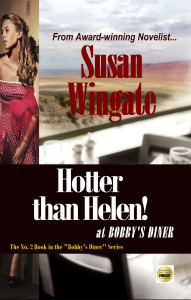 Why did you decide to self-publish?
Why did you decide to self-publish?
After being published and realizing how little marketing effort publishers tend to give to their books and being slightly disenchanted by this fact, I went solo. Marketing is the thing that will sell books in a world that is glutted with great books. So, with my business background intact and my living as a writer at stake, I decided to self-publish. And, boy oh boy, am I glad I did. Not only did the book win three separate finalist awards, Bobby’s Diner also reached several Amazon Best Seller spots and has gotten as high in the rankings as number two.
Did you do much rewriting for this reissue?
Of course. Authors are freaky that way. If we get another chance to edit or add or subtract, we will.
How was the process different the second time around?
Well, when your book is with a publishing house, you have little (and sometimes no) control over the finished product. I once had an editor edit out an entire meaning because of “fixing” one word. They destroyed the passage and weakened the story because of their “fix.” But, it’s a trade-off when you get picked up by a publishing house because having someone accept your work adds credibility to you as an author far beyond what a self-publisher will receive. Is the trade-off worth it? Hmm, not sure. When my self-published works sell and I get those royalty checks, I’m pretty darned happy. Conversely, when my work is published by a press I get a sense of approval, readers get a sense of credibility about my work. I suppose that’s good at the outset but if the story isn’t selling because the publisher is not pushing the book, then, is it worth the representation of having a publisher? Ultimately, it’s each writer’s choice.
When did you first consider yourself a writer?
Well, I’ve written all of my life and my output proliferated around 1995. But late in 1997 is  when I considered myself a writer, while on my way to my home where I live now. I had to drive nearly 2,000 miles to get here. On that road trip, I developed an outline for my first novel. And, the reason this was the point I considered myself a writer is because I stuck with the story and saw it through to its completion. Only a true writer can finish a novel. Writers who only dabble and don’t finish novels they’ve started are not truly committed to writing. If they were, they would learn how to finish their novel. With any craft an artist must go through the work of learning technique and structure. Writing a short story or a novel means understanding the structure of each.
when I considered myself a writer, while on my way to my home where I live now. I had to drive nearly 2,000 miles to get here. On that road trip, I developed an outline for my first novel. And, the reason this was the point I considered myself a writer is because I stuck with the story and saw it through to its completion. Only a true writer can finish a novel. Writers who only dabble and don’t finish novels they’ve started are not truly committed to writing. If they were, they would learn how to finish their novel. With any craft an artist must go through the work of learning technique and structure. Writing a short story or a novel means understanding the structure of each.
If you had to choose, which writer would you consider a mentor?
Well, I actually had a mentor and that was Michael Collins. He’s an international bestselling author and two of his titles are Death of a Writer and Keepers of Truth (which was shortlisted for the 2000 Man-Booker Award).
Your other books include Spider Brains, a quirky Young Adult novel; Drowning, a tale of redemption; and a gritty “Chandleresque” novel, Of the Law. What has motivated you to write in so many different styles?
Isn’t that the million-dollar question! LOL. Stories come to me and not all of them land within one single genre. I love storytelling, therefore I write the story that strikes me most at any given time, one that stays with me, one with a logical flow and the one with a profound ending.
Do you have a favorite genre or book you’ve written?
Not really although I seem to find my list of books falling more toward women’s fiction than other genres. However, my favorite book is always the one I’m currently writing.
What is your current project?
Well, that was a nice segue! The working title of novel number thirteen is called Way of the Wild Wood. This story is about a girl named Meg Nightly whose mother has recently died and who now lives alone with her sad and abusive father. In Meg’s grief she ends up getting lost in the woods near their home. I love this story. I’m also writing to a collaborative novel but for now “Way of the Wild Wood” has me enchanted.
SUSAN WINGATE’s poem “The Dance of Wind in Trees” was published in the April 2013 issue of the Virginia Quarterly Review. Susan’s award-winning, Amazon best seller, Drowning, is now available in audio book version. Susan’s three-Book “Susie Speider” YA Fiction Series is available through her publisher Astraea Press, on Amazon and Barnes & Noble. In 2012, two of Susan’s books made it onto the Top 10 Amazon Best Seller list twice. Drowning, (Susan’s contemporary women’s fiction) won 1st place in the 2011 Forward National Literature Award for the category of Drama. Drowning also won a finalist award for the category of Women’s Fiction/Chick Lit in the 2011 International Book Awards and reached #1 on the Amazon’s Best Seller list.
A vibrant public speaker, Susan offers inspiring, motivational talks about the craft of writing, publishing and marketing, and how to survive this extremely volatile ePublishing industry. She presents lectures and workshops at writing conferences, libraries and book stores around the country. She also loves to visit with book clubs for more intimate chats.


May 23, 2013
Shaking and Rocking to Relax the Writer and Reader
All writers and readers know sitting can be unhealthy. Yet there are times strenuous exercise is not possible. Shaking is a gentle exercise that works to wake up the copy and focus the mind – without moving too far from your desk or chair.
Shaking
Ancient wisdom embodies ecstatic shaking as the oldest medicine. Kalahari Bushman, Quakers, Shakers, Japanese seiki jutsu, Native American shakers of the Pacific Northwest, and many pow-wow dancers use shaking for healing and shamanic experience.
Many traditions use frenzied ecstasy as a prelude to a deep state of relaxation. Not to be confused with St. Vitus Dance or mass hysteria, remnants of ecstatic shaking remain in divers music and spiritual traditions; jazz, blues, rock and roll, and gospel as well as ancient ethnic circle dances, kundalini yoga, and qigong.
Gentle or energetic shaking loosens the joints of the body, breaks up physical and mental stagnation, and opens energy channels. Shaking allows you to let go (and look very silly) while banishing stiffness and shaking off emotional knots. Bradford Keeney, author of Shaking Medicine experienced what he calls enriched intuition from shaking.
How To Do It
Start by imagining you’re Pinocchio and a kindly Geppetto is pulling your strings. Stand, feet apart, eyes closed or almost closed. Soften the knees. Exhale and begin. Try to feel the shaking originating in the belly. Let the breath deepen. Move and wiggle all your parts as if you had no bones. Shake for at least 5 minutes daily for a few days to see if it works for you.
Shaking can be a warm-up, a quick break, or a practice in itself. Laraine Herring, in The Writing Warrior, calls shaking an “energetic flush” for the body and “internal meditation” for the mind. She offers instructions and a YouTube video to introduce writers to the practice of shaking.
Literary Side Trip - A famous member the Sufi dervish cult known for ecstatic dance, the 13th century poet Rumi, was recently called the most popular poet in America.
R ocking
Like shaking, rocking the body connects you to your primal soul. Old-fashioned rocking chairs, swings, and gliders come back in vogue because they make people feel good. Add a rocking chair to your office. Rock, breathe, and relax.
Soothing Rocking Exercise - Sit erect close to the front of a firm chair with your feet on the floor. Close your eyes and, keeping hips evenly on chair, rock back and forth slowly and rhythmically in sync with your breath. If you like, wrap your arms around your body.
Literary Side Trip – Contrary to popular legend, Ben Franklin did not invent the rocking chair, though he did come up with three clever devices to benefit writers: bifocals, the cozy Franklin stove, and the wooden pole with a claw to remove books from high shelves.
Excerpts from Relaxing the Writer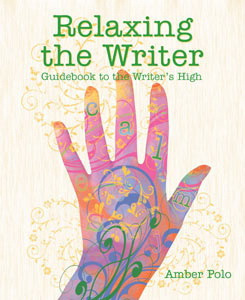
Find more suggestions in Relaxing the Writer
***
Learn More about Shaking as a Practice for writers…
Listen to Laraine Herring talk more about shaking on this video
And a demonstration
Laraine somehow convinced her husband
to demonstrate how to shake -
http://www.youtube.com/watch?v=tJscTrEdBhA
Link to Relaxation Books & CDs on my website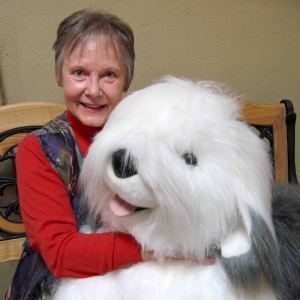 Bio Amber Polo
Bio Amber Polo
A love of books drew Amber Polo into a career as a librarian. A greater love turned her into a writer. The Shapeshifters’ Library series is an urban fantasy filled with books, librarians and dogs and a library everyone will love.
In addition to her two award-winning romance novels, she self-published Relaxing the Writer: Guidebook to the Writer’s High which offers hundreds of tips to help writers and readers relax and is proud of her self-produced, Relaxation One Breath at a Time, a CD that uses her voice to teach relaxation to calm your body and mind and/or help you fall asleep.


May 17, 2013
Words for Writers
Here is a list of some important and interesting words for writers to think about, know and use. Have fun!
ACTION: Action and plot grow out of compelling, interesting characters. Suspense, action, and conflict are what keep the reader interested. Action is presenting the real life evidence through characters, by showing, not telling the story.
BEATS: Beats can be the little bits of action interspersed through a scene, especially in dialogue. For example:
“I don’t even want to go there,” I said.
He laid a hand on my arm. “You want me to drive?”
CONSONANCE: Is the close repetition of the same consonants of stressed syllables, especially at the end of words, with differing vowel sounds. Example: Boat and Night.
DISSONANCE: Is a mingling or union of harsh, inharmonious sounds that are grating to the ear. Often used to create a disturbing or tumultuous atmosphere or confusion or bewilderment in poetry.
EUPHONY: Is the harmony or beauty of a sound that provides a pleasing effect to the ear. It is achieved not only by the selection of individual word sounds, but also by their relationship in the repetition, proximity, and flow of sound patterns.
FLASHBACK: A window to your character’s past. A flashback gives you a way to “show” your character’s past through a scene without “telling” the story through narration. Be very careful in using these so it doesn’t “bump” the reader out of the action & story flow while you are explaining what happened sometime in the past. It can be passive. Keep it very brief and try to use a sense to trigger the memory, e.g. a smell or a sound, etc.
HOMOPHONE: Is a word that has the same in sound as another word, but different spelling and meaning. (For example: Pair as in set of two, and pear as in edible fruit.)
METAPHOR: An analogy between two objects or ideas when you say one item IS another. For example: “Then it was there alongside, the locomotive a sudden tornado, black, huge, screaming…” A SIMILE is saying something is LIKE another: “The bird’s wings were blue as the sky.”
ONOMATOPOEIA: Words that imitate sounds, or any word whose sound is suggestive of its meaning. Using words like a musical instrument to create a specific sound. For example: the words “Splash” or “Plop.”
PARADOX: Is a statement that contains seemingly contradictory elements or appears contradictory to common sense, yet can be true when viewed from another angle. A good character trait to experiment with.
STORY LINE: The plot of a book, film, or dramatic work.
THEME: An idea, point of view, or perception expressed as a phrase, proposition, or question. The root or core of what is expressed.
VISION: A mental image produced by imagination. How someone sees or conceives of something. Discernment or perception; intelligent foresight. The mystical experience of seeing as if with the eyes of characters within your writing.


May 9, 2013
Adeline: A Story of Memories, Growth, and Life
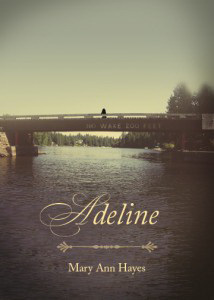 I recently read and enjoyed Adeline, a small but moving book, almost a memoir, an essay on life and its narrow winding path, and growth in maturity and spirituality. I asked Mary Ann to talk about how this book came about.
I recently read and enjoyed Adeline, a small but moving book, almost a memoir, an essay on life and its narrow winding path, and growth in maturity and spirituality. I asked Mary Ann to talk about how this book came about.
by Mary Ann Hayes
The story of Adeline has been playing in my head for so many years, I can’t even say how long. It takes place at a mountain lake in Northern Idaho where I spent my summers growing up, exploring nature with my two sisters and four brothers. There was, and still is, something magical about the place: the old cabin my dad threw together with materials scavenged from buildings one step away from the wrecking ball, the giant evergreens towering everywhere, the massive mountain arms surrounding our small body of water.
Things happened there that have stayed with me my whole life. My brother Jim died of cancer and spent the final days at our lake. His death, the significance of losing him, is depicted in the character Beanie.
The old woman Adeline herself is who I’ve always hoped I would be by the end days of my life, a person who has learned the impact and necessity of love and forgiveness. A woman who is a combination of those who shaped my life and taught me to value what is real and honest and good.
The story of the mountain lion came from a night we had an unexpected visitor on the patio outside the cabin door. The terrifying screams of the huge cat are unforgettable yet absolutely wonderful at the same time.
The mountain stream is one we would follow way up and deep into the forest to check on our water line. It was and still is our water supply for the cabin.
The actual road leading to the lake is not treacherous, yet it is windy and narrow in places. It has always been a reminder to me that life is a narrow winding road we need to travel on with patience, alertness, and awareness.
The demon and the angel were from a reoccurring nightmare I had as a child. They battled for my soul and left  me sleepless many a night and for many years.
me sleepless many a night and for many years.
I began by listing the important things I knew needed to be included in the story such as the willows, the channel, the road, and of course the bridge. I let the character of Adeline stroll through my mind as she made her way from the start to the finish, listening, and then writing down her thoughts and memories. Her memories are, of course, the memories I have when I am there, especially now as I get older.
Once I had an outline down on paper, and I knew I’d left nothing of significant importance out, I couldn’t stop writing. It just flowed! I hope I can write another story like Adeline some day. It was a dream for me.
Finding a publisher was the trick. After careful research, I sent my manuscript to Tate Publishing and Enterprises. They are one of the largest Christian publishers in the country and although Adeline is not a religious story, it certainly is spiritual. It was a pleasure working with them.
Mary Ann Hayes lives on an island in Washington State with her husband of thirty-five years and two dogs.
She says, “My passion for writing stems from a love for the English language. Words are amazing. They are strong and powerful and must be used with consideration. Words can make or break a life, the power in their use is so great. Naturally, a love of words leads me to be an avid reader. A good novel on a rainy day is like rich dark chocolate and a fresh cup of coffee. It doesn’t get much better.”
Mary Ann has also written A Friend Like Frank, a contemporary women’s novel, a bit of a romantic comedy, which is available in paperback and as an e-book through Amazon, or autographed through her website, http://www.maryannhayes.com She has a sequel due out soon, The Trouble with Tony.


May 2, 2013
32 Great Reasons to Read Good Book
by John Kremer
Here are 32 great reasons to read more books. Please share.

To escape your normal life.
To travel to real destinations.
To explore new worlds.
To imagine more than you could on your own.
To understand something new.
To understand something old.
To connect with the author.
To connect with other readers.
To compare dreams, realities, and in-between.
To laugh and enjoy.
To deepen your understanding and insight.
To know more than you could learn on your own.
To learn what you don’t know.
To learn what you do know.
To discover something extraordinary.
To meet incredible characters.
To build a larger vocabulary.
To cry after a great read.
To be entertained by a great story.
To relax with a great storyteller.
To stimulate thought.
To grow your spirit.
To find motivation to do more.
To go on a great adventure.
To learn how others live or have lived.
To explore inner dimensions.
To educate yourself.
To inspire your own writing.
To learn how to change the world.
To discuss in a reading group.
To share a good book with your friends.


April 25, 2013
Don’t Shoot the Painter
by Donis Casey
When I write an Alafair Tucker novel, I work hard to authentically depict what life was like in the pre-World War I rural Oklahoma. I decided early on that I wanted to try and evoke not just the events of the time, but the smells, the tastes, the sound, the hot and cold of it — the daily one-foot-in-front-of-the-other life of a farm wife with ten children. I love the language, too. When I was a teenager, my uncle walked into our house one day and said, “What in the cat hair is going on?” How could I let such a colorful way of expression fade into oblivion?
I’m very careful with dialect when I write, and often worried about it, too. The people in 1916 Boynton, Oklahoma, did in fact use terms and phrases that are now cliche. I know this is so because that is the way my grandparents talked, all four of whom were in their teens and twenties in the 1910′s. In truth, I don’t write exactly like they talked, because it would not be understandable if I did. It’s a beginner’s mistake to try transliterate a character’s accent onto the page. But the choice of words used and the very way that those words are combined will evoke the time and place.
The trick to writing dialect is to simply give a flavor of the language by use of grammar, word order, rhythm of speech, and regional phrases.There is a very big difference between dialect, which is the meaning and use of words and phrases of a particular region or ethnicity, and accent, which is the way words are pronounced. That is, a native Oklahoman in 1916 would probably have pronounced the word panther as painter, oil as awl, and point as pint. But I would not have my character say, “I just shot me a painter.” Because you would look at that, Dear Reader, and say huh?
Sometimes writing dialect for the near past is trickier than for the more distant past. Would my teen boy have said “jeepers” in 1916?* How about, “I’ll be f—ed?”** How can I know? Sometimes it’s tough, but we do our best. Popular literature of the time and etymological dictionaries like the good old Oxford English Dictionary help a lot.
In my experience, persons of Alafair’s particular era and place spoke with an amazing blend of ungrammatical, nonstandard usage and beautiful, flowery phraseology that would not look amiss in Shakespearean dialog. Here’s a passage from the fifth Alafair Tucker novel, Crying Blood:
“You’re a spiteful heathen, McBride…There’s no stud in Oklahoma can hold a candle to yon stallion and well you know it. Talk some sense into the fool, Shaw. I’d have to haul my mares clean to Tennessee to find another half so fine, nor could I buy another of such quality even if I could afford to scour the country to find him.”
Some of the words used in the paragraph are archaic, but not unfamiliar, such as “yon”, or the way the character uses the word “clean” instead of “clear”. And the word order is different from what one might hear these days. But I didn’t write ‘Yore uh spotful haythun, McBrodd.” I trust that you heard it that way in your head, anyway, Dear Reader.
I’m fairly well educated myself, and I grew up determined to speak English in as standard a fashion as I could. My parents were college educated, but  their parents and older relatives weren’t, so I grew up around country people. My most schooled grandparent graduated from the eighth grade, which was as far as most people in that time and place could go. One grandparent only got as far as the third grade. But just because you didn’t get very far in school doesn’t mean you aren’t smart. Michael Caine, who is Cockney, once said that people too often judge your intelligence by your accent.
their parents and older relatives weren’t, so I grew up around country people. My most schooled grandparent graduated from the eighth grade, which was as far as most people in that time and place could go. One grandparent only got as far as the third grade. But just because you didn’t get very far in school doesn’t mean you aren’t smart. Michael Caine, who is Cockney, once said that people too often judge your intelligence by your accent.
I fear I did that too often during my youth. Now that I’m not so young, I realize that my grandma knew a heck of a lot more about people and about living than I do, lack of advanced degrees notwithstanding.
Writing dialect is dangerous business, any as any writer knows. It’s really hard not to sound ridiculous, or worse, to sound like you don’t respect your characters. So most teachers warn students away from attempting it. Now that it’s hard to find strong dialect anywhere in America, I find that I miss hearing it. To me, an old Oklahoma way of speaking sounds like my warm and loving childhood, and that’s why I try to lovingly convey a flavor of it in my writing.
________________
*no
**yes
_______________
Donis Casey is the author of six Alafair Tucker Mysteries, The Old Buzzard Had It Coming, Hornswoggled, The Drop Edge of Yonder, The Sky Took Him, Crying Blood, and the recently released The Wrong Hill to Die On. Her series featuring the sleuthing mother of ten children is set in Oklahoma and Arizona during the booming 1910s. Donis has twice won the Arizona Book Award and her books have been finalists for the Willa Award and the Oklahoma Book Award. Her first novel, The Old Buzzard Had It Coming, was named an Oklahoma Centennial Book. Read the first chapter of each book at Donis’ website.









